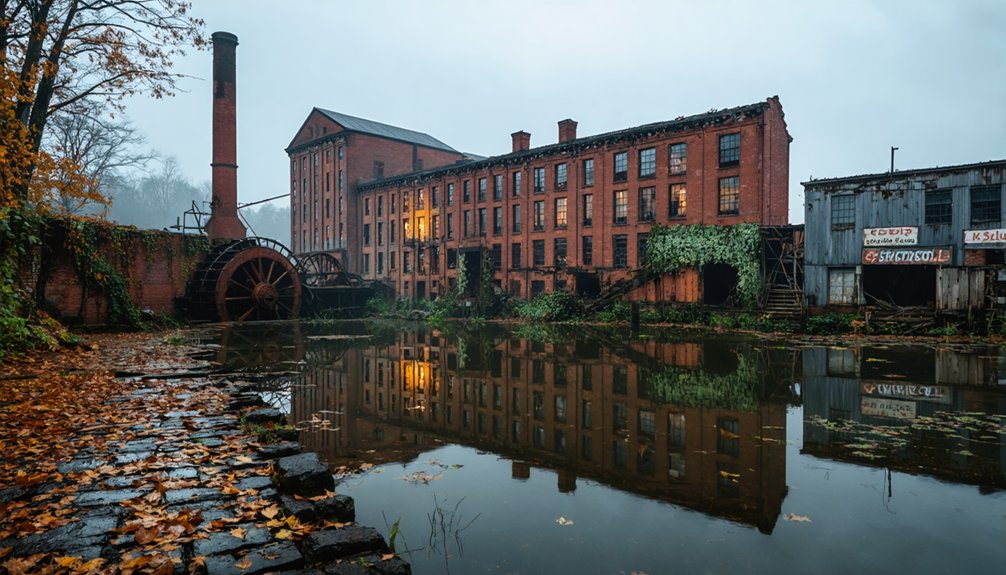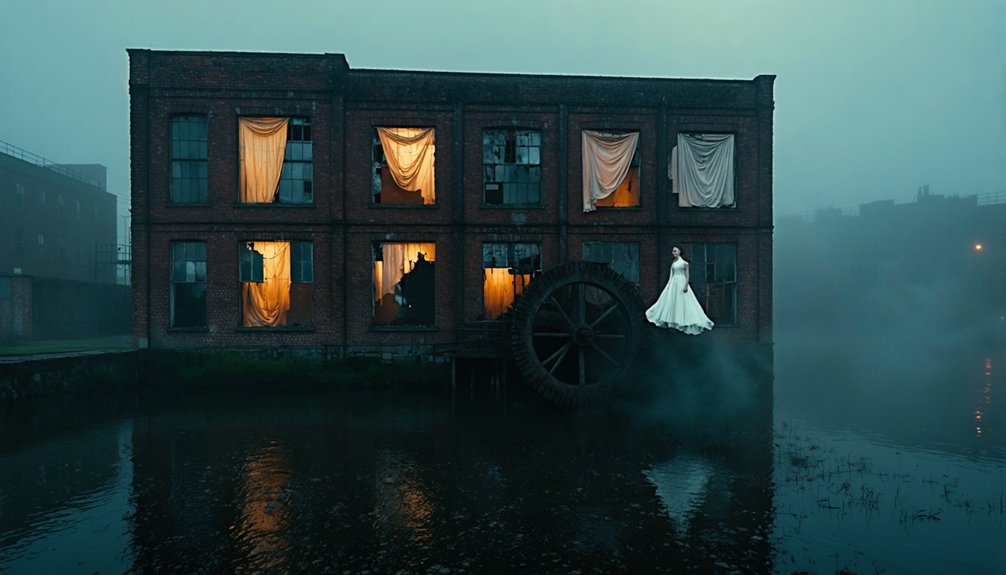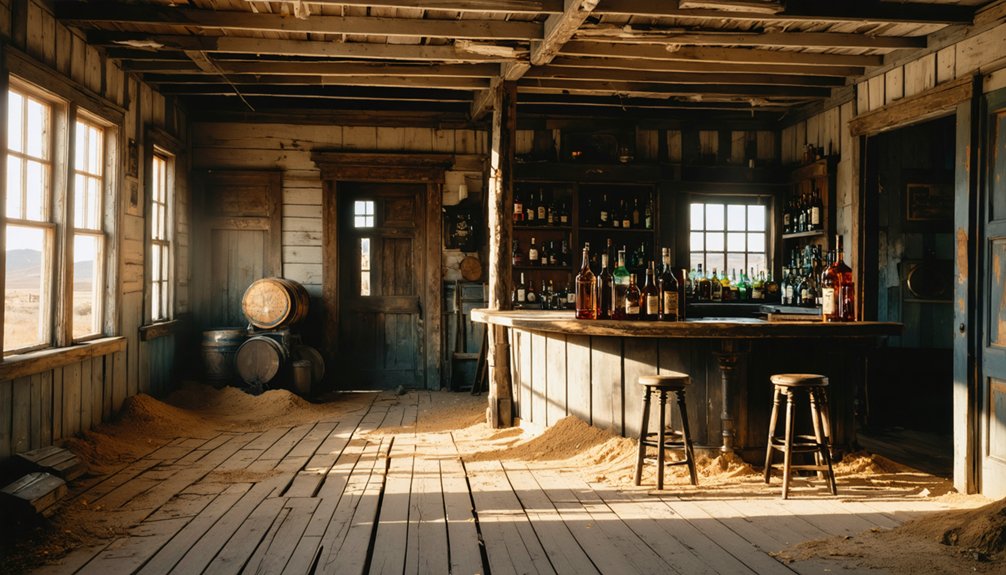When exploring ghostly mill towns, inform others of your plans, wear protective clothing, and carry proper lighting with backup batteries. Pack first aid supplies, water, and snacks. Research the site’s history and obtain legal access permissions. Assess structural hazards like weak floors and decaying timbers before entering buildings. Document respectfully through photography while following established paths. Practice “leave no trace” ethics by never removing artifacts or altering the environment. These abandoned industrial landscapes hold countless stories waiting to be uncovered.
Key Takeaways
- Always inform someone of your exploration plans and expected return time before visiting abandoned mill towns.
- Wear protective clothing including sturdy boots and bring a high-quality headlamp with backup batteries.
- Research the site’s history and structural hazards before visiting to understand safety concerns specific to that location.
- Respect property boundaries, obtain proper permissions, and follow established paths to minimize environmental impact.
- Document through photography rather than collection, leaving all artifacts in place for preservation and future visitors.
Plan Your Visit During Optimal Seasons
When planning an excursion to America’s abandoned mill towns, timing becomes perhaps the most critical factor in determining the quality of your experience.
Summer months (June-August) offer significant seasonal advantages with clear roads, warm weather, and fully operational facilities. You’ll find the most services available but must contend with larger crowds.
For best timing, consider fall (September-November), when the crisp air and vibrant foliage create an atmospheric backdrop with fewer tourists.
Spring presents a viable alternative in milder regions, though unpredictable weather may arise.
Avoid winter explorations entirely—snow-covered, icy roads render many ghost towns inaccessible without specialized equipment.
The shoulder seasons strike an ideal balance between accessibility and solitude, allowing you to experience these haunting industrial relics without the summer crush.
Pack essential exploration gear including sturdy hiking boots and a first aid kit to ensure your safety while investigating these historical sites.
Several ghost towns like Bodie and St. Elmo are best visited during the warmer months when historic structures are fully accessible to visitors.
Research the Town’s Industrial Legacy
Before exploring a ghost mill town, you’ll want to examine how its production methods shaped both its physical layout and economic trajectory.
Consider investigating the town’s resource access patterns, which often reveal why the settlement arose in that particular location—whether positioned near water power, timber reserves, or transportation networks.
Historical accounts of labor movements and worker experiences will provide vital context for understanding the human dimension of these industrial spaces, including immigrant communities, union activities, and the socioeconomic conditions that defined daily life. During the first Industrial Revolution, crowded and poor living quarters with shared toilets became common for the working class population. Many mill towns in New England preserve their industrial revolution heritage through national historical parks like those in Lowell that showcase waterways and mill buildings.
Mill Production Methods
As you wander through the ghostly remnants of this once-thriving industrial center, the echoes of its steel production heritage remain etched in rusting machinery and towering structures.
Look for blast furnaces—sometimes reaching ten stories high—where intense heat transformed raw materials into molten metal through hot air blasts.
Notice the evolution of casting techniques from Huntsman’s crucible steel process to continuous casting. You’ll recognize soaking pits where ingots were reheated to 2450°F before rolling.
The Bessemer process revolutionized steel forging, while later BOF and EAF methods increased efficiency dramatically.
Identify the mechanical ghosts of charging machines, hot-metal cranes, and knee-and-column mills that once buzzed with activity.
These industrial artifacts tell the story of steel’s transformation from labor-intensive craft to automated precision manufacturing. Benjamin Huntsman’s crucible technique in 1740 represented a pivotal advancement that improved both quality and production quantity compared to earlier methods. Search for remnants of rail-tractor systems that once transported hot ingots between production stages throughout the mill complex.
Resource Access Patterns
Researching the shadowy history of abandoned mill towns requires strategic navigation through a labyrinth of archival resources that, while often fragmented, collectively reveal the industrial narrative that shaped these communities.
You’ll encounter varying resource availability depending on the town’s size and historical significance. Digital archives have democratized access, but physical collections often contain the richest material. The dramatic decline from 97 manufacturing facilities to merely six remaining operations in areas like Northern Liberties exemplifies the industrial transformation you should document. Manufacturing job losses have been substantial in legacy cities, with low-paying service jobs replacing once-thriving industrial employment.
- Local historical societies hold treasure troves of factory blueprints and business records, though limited hours create access barriers.
- Environmental data from EPA’s Toxic Release Inventory illuminates industrial activity patterns and operational timelines.
- Newspaper archives capture the rhythm of mill life through coverage of openings, strikes, and closures.
- Census records track demographic shifts, revealing how resource availability influenced population fluctuations when industries collapsed.
Labor History Stories
The forgotten pulse of American industrial growth beats strongest in the labor histories of mill towns, where workers’ stories illuminate both the promise and peril of rapid industrialization.
As you explore, seek accounts of labor struggles in places like Lowell, where 10,000 mill workers lost their jobs during the Civil War, or Appalachian coal towns where exploitation persisted despite modern amenities.
Document how welfare capitalism attempted to secure worker loyalty through better housing and social services.
Notice how community resilience emerged through ethnic diversity and shared hardship in company-controlled environments.
Examine how the New Deal’s labor reforms ultimately undermined the company town model by promoting worker independence.
These narratives reveal how industrial labor towns served as crucibles where American identity was forged through the tension between corporate control and workers’ pursuit of dignity. Significant historical labor conflicts like the Pullman Strike of 1894 resulted in federal intervention and illustrated the mounting tension between company interests and workers’ rights.
Approximately 2,500 company towns were established across America during the late 1800s and early 1900s, with about 500 of these industrial settlements located in what would become the Appalachian Region.
Pack Essential Safety Gear and Supplies
Exploring forgotten mill towns demands meticulous preparation of safety equipment to traverse the numerous physical and environmental hazards these dilapidated sites present. Your safety equipment arsenal should include respiratory protection with N95 or P100 filters to shield against asbestos and mold spores, plus durable leather gloves to prevent lacerations from jagged metal and broken glass.
Emergency preparedness isn’t optional—inform someone of your exploration plans and expected return time.
- Wear sturdy boots and long sleeves to protect against debris, nails, and environmental irritants
- Carry a high-quality headlamp with backup batteries for traversing dark interiors
- Pack a thorough first aid kit with antiseptics, bandages, and doorstops to prevent entrapment
- Bring sufficient water and non-perishable snacks to sustain energy during unpredictable explorations

Carefully mapping your route through forgotten industrial landscapes requires a blend of historical detective work and modern navigation techniques to access these hidden time capsules.
Cross-reference historical society archives with modern trail maps to pinpoint authentic access points that won’t lead you astray. Many original mill town trails have become overgrown or rerouted over decades.
The lost pathways of industry reveal themselves only to those who marry yesterday’s knowledge with today’s precision.
For reliable trail navigation, consult recent visitor reports on exploration forums, noting GPS coordinates and seasonal warnings. Mark waypoints at key junctions and prepare for unmarked paths that may require backtracking.
Before setting out, verify legal access through local government websites—many sites require permits or have restricted areas due to preservation efforts. Respect private property boundaries and posted signage while seeking out lesser-known entry points detailed in old railroad or mining company maps.
Identify Structural Hazards Before Entering
When entering abandoned mill structures, vigilant assessment of structural integrity can mean the difference between safe exploration and catastrophic injury. Your hazard assessments should focus on connections between columns and girders—particularly cast iron components that fail without warning.
Perform thorough structural inspections of floors, which may be weakened by chemical impregnation and fire cuts in joists.
- Look for unmarked elevator shafts and freight lifts that create dangerous fall hazards
- Examine support timbers carefully—they may appear solid but have severe internal decay
- Check for mixed construction materials (cast iron columns with timber beams) that create uneven load distribution
- Be alert for contamination from industrial chemicals that accelerate structural degradation and present additional health risks
Document Architectural Remnants Respectfully
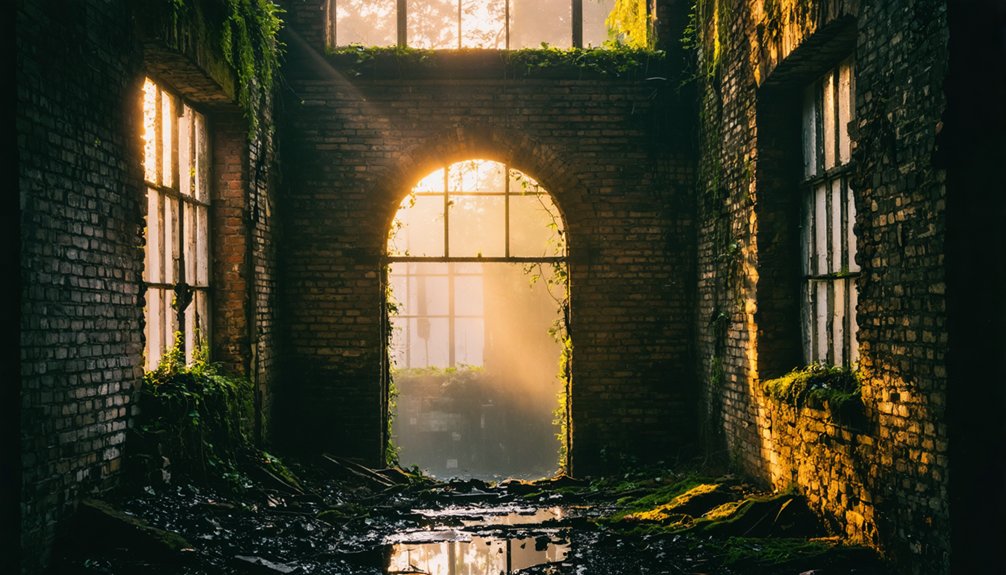
Beyond identifying physical hazards, your responsibility as an explorer extends to preserving the historical record through thoughtful documentation.
Capture architectural authenticity through non-invasive methods—photograph brickwork patterns and construction techniques without disturbing original materials. Use varied lighting angles to highlight structural details that reveal historical significance.
Always verify site ownership and secure necessary permissions before documenting these remnants. Follow established paths to minimize your physical impact while recording extensive details from village layouts to minute architectural elements.
Avoid removing artifacts or touching fragile surfaces—even seemingly insignificant mortar fragments hold preservation value.
Engage local historians when possible, incorporating their knowledge into your documentation. By sharing your respectful records with preservation societies, you’ll contribute to conservation efforts while honoring these ghostly structures that silently narrate our industrial heritage.
Recognize Signs of Daily Life in the Ruins
Stepping through the skeletal remains of mill towns, you’ll discover that these abandoned structures aren’t merely architectural curiosities but living archives of human experience.
Observe how worker housing clustered near mills reveals daily routines organized around labor, while community spaces like general stores and bakeries illuminate social connections.
When examining these sites, you’re witnessing the intimate framework of past lives.
- Search for household artifacts—furniture fragments, tools, and personal items tell stories of domestic life beyond work hours
- Notice spatial relationships between residential, recreational, and industrial buildings that defined community rhythms
- Look for evidence of company stores and controlled pricing that shaped economic dependencies
- Identify remnants of communal areas like parks and gymnasiums where residents forged collective identities away from mill operations
Practice Ethical Photography Techniques
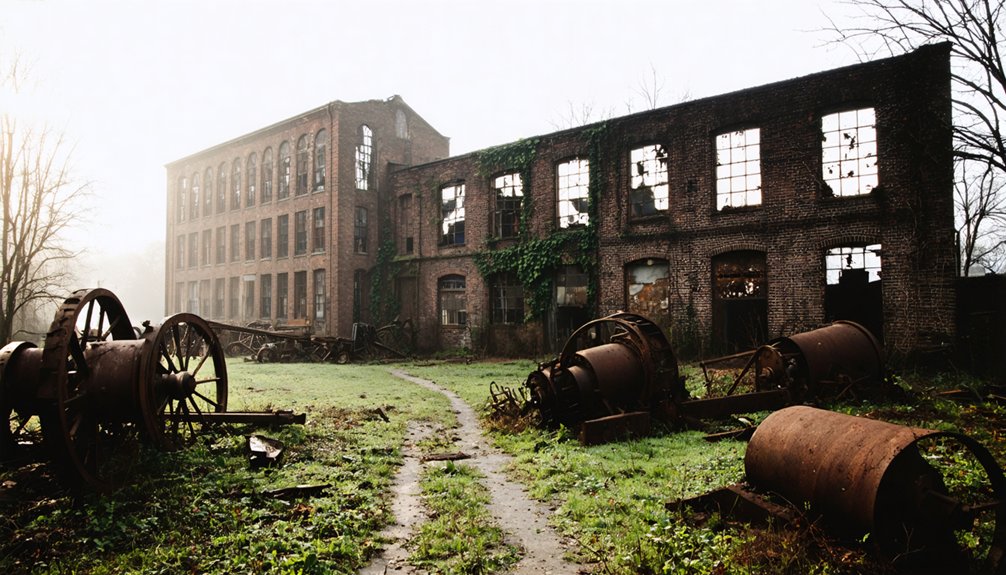
When photographing abandoned mill towns, you’ll achieve more authentic documentation by framing shots carefully without moving objects or altering scenes.
Your camera’s perspective should respect the natural state of decay, capturing the weathered textures and fallen structures as testimony to time’s passage rather than as aesthetic props for manipulation.
Maintain ethical boundaries by photographing from established pathways, using tripods on stable surfaces, and considering how your images might influence others’ treatment of these fragile historical remnants.
Frame Without Disturbing
Capturing the haunting beauty of abandoned mill towns requires a disciplined approach to photography that honors these sites’ historical integrity.
When composing your frame, rely on careful positioning rather than rearranging elements. Natural lighting creates authentic atmosphere while minimizing your environmental impact—early morning or late afternoon offers dramatic shadows that enhance architectural details without disturbing delicate surfaces.
- Use wide-angle lenses to capture extensive scenes without needing to reposition objects
- Employ reflections in broken windows or puddles for creative frame composition
- Work with natural shadows and light beams through collapsed roofs to create depth
- Focus on existing arrangements of artifacts—their authentic positioning tells a more powerful story
Remember that the most compelling images emerge from patience and respectful observation rather than manipulation of these fragile historical landscapes.
Document Decay Respectfully
Ethical photography in these forgotten spaces extends beyond merely capturing images to actively participating in preservation through your documentation choices.
When photographing deteriorating mill structures, prioritize natural lighting or gentle flashlights rather than harsh flashes that can damage fragile pigments and surfaces.
Don’t rearrange artifacts for “better” compositions—their authentic placement tells the true historical narrative.
Experiment with HDR, bracketing, or light painting techniques to capture detail without physically disturbing the environment.
Focus your lens on textures, shadows, and architectural elements that convey the passage of time without exploiting the site’s vulnerability.
Your photographic decisions reflect your commitment to ethical exploration and historical preservation.
Connect With Local Historical Societies
Local historical societies represent the beating heart of ghost town research, functioning as invaluable gatekeepers to the past and present of America’s abandoned mill towns. These organizations preserve local heritage through archives, photographs, and oral histories that you can’t find elsewhere.
Before venturing into the field, establish relationships with these community engagement hubs to access deeper understandings of forgotten industrial landscapes.
- Access specialized maps and property records to locate hidden mill sites
- Participate in organized preservation efforts, connecting with like-minded explorers
- Gain legitimate access to restricted locations through proper channels and permissions
- Learn about safety concerns and ethical considerations specific to regional ghost towns
Their expertise transforms random exploration into meaningful historical investigation, while their collaborative networks offer pathways to preservation opportunities that honor these industrial relics properly.
Preserve the Site’s Integrity for Future Explorers

The sacred responsibility of preserving mill town ruins falls on every visitor who treads upon these hallowed grounds.
Embrace collective stewardship by adhering to established pathways, avoiding fragile structures, and never removing artifacts or materials—no matter how small. Document without disturbing: photograph rather than collect, observe without altering.
Your exploration should leave no trace—carry out all waste, refrain from lighting fires, and resist the temptation to carve your name into history.
Report structural hazards to authorities, and when encountering others, gently advocate for sustainable practices that maintain these sites’ authenticity.
Remember: these silent witnesses to industrial history aren’t yours alone.
Through conscientious exploration, you guarantee that future generations can experience the same haunting beauty and historical significance that captivates you today.
Frequently Asked Questions
Are Dogs Allowed in Abandoned Mill Towns?
Like moths to forgotten flames, you’ll find most abandoned mill towns restrict dogs. When allowed, leash laws apply—your canine companion’s safety demands vigilance amid hazardous ruins and structural dangers.
How Do I Identify Poisonous Plants Around Old Structures?
When identifying poisonous plants, look for compound leaves, unusual stem coloration, distinctive berries, and hair-like structures. Carry identification guides and always wear protective clothing—your safety precautions should never be compromised.
Can I Use Metal Detectors at Ghost Town Sites?
You can’t legally metal detect at most ghost towns due to historical preservation concerns. Federal regulations prohibit artifact removal, and you’ll need explicit permission on private land to avoid trespassing charges.
What Paranormal Equipment Should I Bring for Investigations?
You’ll need an EMF meter to detect energy fluctuations, spirit boxes for communication, digital recorders for EVPs, thermal cameras for cold spots, and sturdy flashlights for traversing the darkness of abandoned structures.
How Do I Distinguish Between Public and Private Ghost Towns?
Like Orpheus traversing the underworld, you’ll need to research before visiting. Check for public access signs and official management websites, while respecting “No Trespassing” indicators that signal private ownership of historic sites.
References
- https://www.visitredwoods.com/listing/falk-historic-logging-ghost-town/526/
- https://hiddenbritainse.org.uk/what-i-learned-from-ghost-town-exploration/
- https://www.savetheredwoods.org/blog/spooky-redwoods-ghost-town-remains-a-presence/
- https://www.youtube.com/watch?v=bGi9Y0tsT5w
- https://www.geotab.com/ghost-towns/
- https://en.wikipedia.org/wiki/Ghost_hunting
- https://www.christywanders.com/2024/08/top-ghost-towns-for-history-buffs.html
- https://research-repository.st-andrews.ac.uk/bitstream/handle/10023/26957/Thesis-Danielle-Woodworth-complete-version.pdf?isAllowed=y&sequence=4
- https://albiongould.com/ghost-towns-to-visit-in-the-states/
- https://dl.uncw.edu/etd/2011-1/r1/dibenignom/mariaelenadibenigno.pdf

